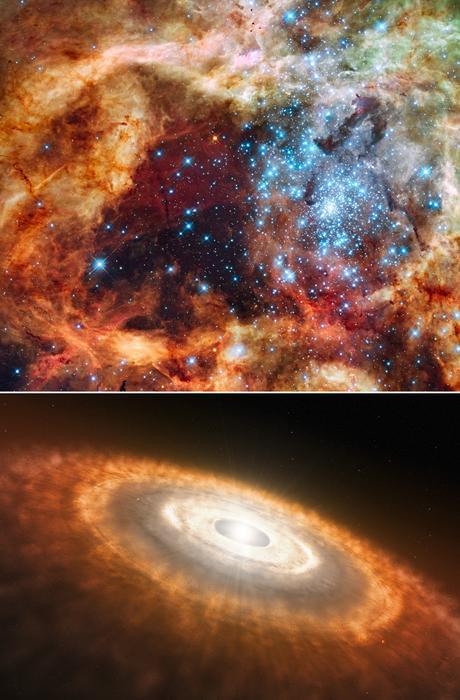The location of the solar system’s outer boundary is a point of contention among astronomers. There are three possible candidates, which “all have merit.” But which one is best?



After three years of collecting scores of data on hundreds of stars, the ULLYSES (Ultraviolet Legacy Library of Young Stars as Essential Standards) survey conducted by NASA’s Hubble Space Telescope officially ended in December 2023, culminating in 220 total stars examined during the survey on data regarding their size, distance from Earth, temperature, chemical characteristics, and rotational speed. Additionally, ULYYSES also contains another 275 stars from the Hubble archive, providing researchers with several decades of new stellar data and holds the potential to help astronomers gain new insights into stellar formation and evolution throughout the universe.
Hubble image of a star-forming region known as the Tarantula Nebula, which contains massive, young blue stars, which was observed during the ULYYSES survey (top panel). Artist’s illustration of a cooler, redder, young star smaller than our Sun that is still gathering material from its planet-forming disk (bottom panel). (Credit: NASA, ESA, STScI, Francesco Paresce (INAF-IASF Bologna), Robert O’Connell (UVA), SOC-WFC3, ESO)
“I believe the ULLYSES project will be transformative, impacting overall astrophysics – from exoplanets, to the effects of massive stars on galaxy evolution, to understanding the earliest stages of the evolving universe,” said Dr. Julia Roman-Duval, who is Implementation Team Lead for ULLYSES and an Associate Astronomer at the Space Telescope Science Institute (STScI). “Aside from the specific goals of the program, the stellar data can also be used in fields of astrophysics in ways we can’t yet imagine.”
While during Apollo 13 the phrase “Failure is Not an Option” was coined, in life and especially for students, failure must be an option for growth. In this talk, Michelle Lucas encourages failing forward. Michelle Lucas was raised in the Chicagoland area and found a passion for space very early in her life. She studied Aerospace Engineering, Communications & Space Studies at Purdue University and Embry Riddle Aeronautical University. During this time she conducted microgravity fluids research on NASA’s KC-135 aircraft and also worked as a counselor at Space Camp in Florida. After graduation from college, Michelle spent 11 years working at NASA’s Johnson Space Center. She began on the Safety Reliability & Quality Assurance Contract as part of the Payload Safety Review Panel for experiments flying to the International Space Station. After this she worked as a Flight Controller in Mission Control for the International Space Station for the Ops Plan Group and as a Astronaut Technical Instructor in the Daily Operations Group. Additionally she worked with each of the International Partners (European Space Agency – ESA, Japanese Space Agency – JAXA and the Russian Space Agency) in the field of Daily Operations, Flight Controller and Instructor Training. Michelle was responsible for the basic instructional training of all technical instructors for in the US as well as for the ISS International Partners. Michelle was part of the Core NASA Extreme Environment Mission Operations (NEEMO) team for 9 missions where astronauts would carry out analog space missions underwater in the Aquarius habitat. Along the way, Michelle found she has a passion for exciting the next generation and founded the non-profit Higher Orbits to use space to excite and inspire students about STEM, STEAM, Leadership, Teambuilding and Communication. Higher Orbits flagship program is called Go For Launch! This program allows students work with an astronaut and other accomplished individuals in the fields of Space, STEM and STEAM. Additionally, Michelle and a business partner run uniphi space agency – a talent management company for retired astronauts. Michelle is proud to be a Space Camp Alumni and member of the Space Camp Hall of Fame and believes that collaboration in space and STEM is the key to the stars! Space Inspires! This talk was given at a TEDx event using the TED conference format but independently organized by a local community.

3 recent technology stories.
The World Economic Forum’s Centre for the Fourth Industrial Revolution helps industries and economies harness the full potential of technologies around the world.
Explore the latest technology stories here:
Top tech news: Chinese flying taxi start-up receives initial safety certificate; NASA launches mission to metal-rich asteroid; investments in climate tech fall.


New insights into near-Earth space’s hazardous environment could revolutionize space weather prediction, driven by collaborative international research.
A challenge to space scientists to better understand our hazardous near-Earth space environment has been set in a new study led by the University of Birmingham.
The research represents the first step towards new theories and methods that will help scientists predict and analyze the behavior of particles in space. It has implications for theoretical research, as well as for practical applications such as space weather forecasting.

Scientists quantify a previously overlooked driver of human-related mercury emissions.
About 10 percent of human-made mercury emissions into the atmosphere each year are the result of global deforestation, according to a new MIT study.
The world’s vegetation, from the Amazon rainforest to the savannahs of sub-Saharan Africa, acts as a sink that removes the toxic pollutant from the air. However, if the current rate of deforestation remains unchanged or accelerates, the researchers estimate that net mercury emissions will keep increasing.


Computer simulations are giving us new insight into the riotous behavior of cannibal neutron stars.
When a neutron star slurps up material from a close binary companion, the unstable thermonuclear burning of that accumulated material can produce a wild explosion that sends X-radiation bursting across the Universe.
How exactly these powerful eruptions evolve and spread across the surface of a neutron star is something of a mystery. But by trying to replicate the observed X-ray flares using simulations, scientists are learning more about their ins and outs – as well as the ultra-dense neutron stars that produce them.

Southwest Research Institute has invested in research to enhance the capabilities of spacecraft instruments. Consequently, they have developed more effective conversion surfaces for the detection and analysis of low-energy particles in outer space.
Led by Dr. Jianliang Lin of Mechanical Engineering and Dr. Justyna Sokół of the Space Science Division, the project could potentially change our understanding of space physics and exploration.